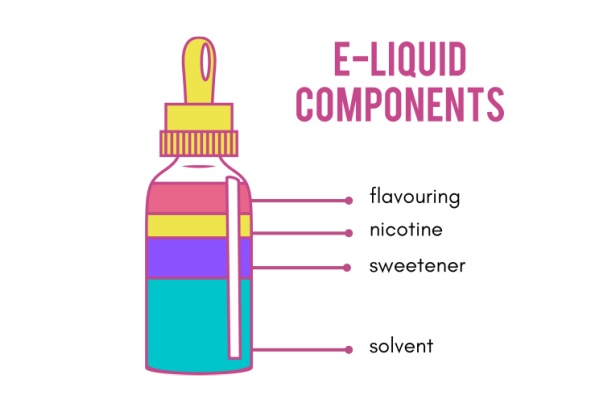How to Inhale Vape
Understanding the right way to inhale ensures a smoother experience and helps prevent coughing or irritation, especially for beginners.
Read More >>WARNING: THIS PRODUCT CONTAINS NICOTINE. NICOTINE IS AN ADDICTIVE CHEMICAL.
E-Liquid is made up of just a few different ingredients: Propylene glycol (PG), vegetable glycerin (VG), water, flavoring, and nicotine. E-liquids typically contain both PG and VG, with one of the two often more dominant than the other.
Making e-liquid is a lengthy process, and like any other recipe, e-liquid ingredients must be carefully measured before mixing. This is especially important with nicotine as it must be measured perfectly to ensure the correct nicotine percentage is achieved.
First the flavors are added to the base of PG and VG and then the mix. Usually only a small amount of flavoring is needed to give the e-liquid the punch it needs. Next, the nicotine is added to the mixture, which is then shaken to make sure the ingredients mix together. The e-liquid is then left to stand for a few days to allow the flavor to become richer or deeper. This process is sometimes informally referred to as “aging” and works in the same way that you might age a cut of meat or let a bottle of wine breathe before drinking it.
Different manufacturers will have lots of variation in the flavours they offer – usually you will find at least a few classic flavours like Menthol and Tobacco, plus a choice of different nicotine strengths. Here at blu, we’re very proud to offer a range of 6 different blu 2.0 liquidpods for use with our closed Sikary 2.0 device; and 10 different blu e-liquids for our open blu PRO device.
We offer flavours in 2 different nicotine strengths: 9mg/ml and 18mg/ml. Both blu 2.0 pods and blu e-liquids come in Menthol, Golden Tobacco, and fruity flavours. There are also some additional flavours that are only available in one format, for example, our Fresh Mango liquidpods or Tropic Tonic e-liquid.
The e-liquids or “juices” used in electronic vaping devices generally consist of three key components: solvents, flavors, and sweeteners, with some juices also containing nicotine. When you inhale the aerosol vapor produced by these devices, you are also inhaling the fine particles of these ingredients.

E-cigarettes like Juul contain cartridges or pods of e-liquid made with water, nicotine, a propylene glycol or vegetable glycerin base, and flavorings. But with thousands of brands available and no set FDA standards, it can be difficult to determine exactly what is in a vape’s e-liquid.
It’s difficult to determine what’s in the thousands of different e-liquids, also called e-juice or vape juice, sold for e-cigarettes. That’s partly because the U.S. Food and Drug Administration hasn’t reviewed the ingredients or set standards. There are many brands and flavors with many different ingredients.
Acetaldehyde and formaldehyde
These chemicals are known to cause cancer.
A weed killer that can cause irreversible lung damage.
A compound found in car exhaust. Long-term exposure may cause blood problems and cancer of blood-forming organs, such as leukemia.
Toxic metal that increases the risk of breathing problems such as chronic obstructive lung disease and emphysema. It’s also found in traditional cigarettes.
Chemical compound used to give food a buttery flavor. Studies link inhaling it to lung disease called bronchiolitis obliterans, also known as “popcorn lung.”
Diethylene glycol
Clear odorless liquid with a sweet taste typically found in industrial products such as antifreeze. It’s used as a base in e-liquids. It’s toxic and is linked to lung disease.
Heavy metal toxicity may damage functioning of lungs, brain, liver, kidneys and other organs.
A highly addictive chemical that can affect the heart and breathing.
A clear, odorless liquid that’s used as antifreeze and a food addictive. It’s used as a base in e-liquids. It turns to vapor when heated but may produce propylene oxide, a known carcinogen.